
United Office Building, now known as the Giacomo, is a historic Mayan Revival, a subset of art deco, skyscraper in Niagara Falls, New York, US.
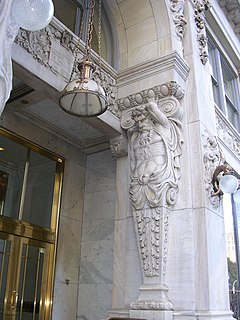
The Candler Building is a 17-story highrise at 127 Peachtree Street, NE, in Atlanta, Georgia. When completed in 1906 by Coca-Cola magnate Asa Griggs Candler, it was the tallest building in the city. This location where Houston joins Peachtree Street was the location of one of the earliest churches in the city which was built on land donated by Judge Reuben Cone in the 1840s. It forms the northern border of Woodruff Park.
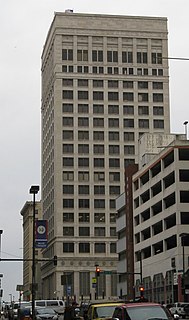
925 Grand is the former headquarters of the Federal Reserve Bank of Kansas City and was the oldest building in active use of any Federal Reserve Bank. It was added to the National Register of Historic Places in 2007.

The Manhattan Building, also known as the Phoenix Building or the Phoenix-Manhattan Building, is a historic skyscraper in Muskogee, Oklahoma. The building has eight stories, containing 50,957 square feet (4,734.1 m2) of floor space, and was initially intended as the home of the Manhattan Construction Company, reportedly Oklahoma's first incorporated business. It was built in 1911 with a reinforced concrete frame and gray brick cladding. These walls were lined with windows to provide light and ventilation, the latter were essential to cope with torrid Oklahoma summers in an era when hardly any large buildings had air conditioning. It was built in Sullivanesque architectural style, with two-story columns flanking the entrance and a second floor cornice with dentils. The entry opened into a two-story lobby whose walls were covered with tile. A rooftop penthouse was added in 1957. The Manhattan Building was added to the National Register of Historic Places for architectural significance in 1983.

The Laura Street Trio is a group of three historic buildings located on and near Laura Street in downtown Jacksonville, Florida. The Trio consists of two perpendicularly arranged skyscrapers, the Florida Life Building and the Bisbee Building, plus a third structure, the Old Florida National Bank, which is framed by the other two in a unique pattern. The three buildings, constructed in the wake of the Great Fire of 1901, are architecturally significant, but are currently endangered.
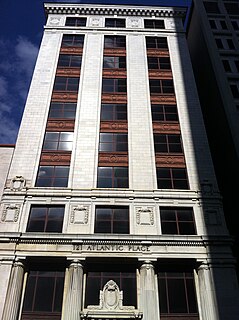
121 Atlantic Place, formerly the Atlantic National Bank Building, is a historic skyscraper in Jacksonville, Florida. It was built in 1909 as the headquarters for the Atlantic National Bank, and is located at 121 West Forsyth Street. It was the tallest building in Jacksonville and in Florida from 1909 to 1912, and remains an office building today.

The Federal Building and U.S. Courthouse, also known as U.S. Courthouse, Sioux Falls, is a historic federal office and courthouse building located at Sioux Falls in Minnehaha County, South Dakota. The building is still in use as a federal courthouse, being the seat of the United States District Court for the District of South Dakota. The structure is listed on the National Register of Historic Places.

Colcord Hotel is a luxury boutique hotel located in downtown Oklahoma City, in the U.S. state of Oklahoma. The building was finished in 1909 and has been considered Oklahoma City's first skyscraper. It is 145 feet (44 m) tall and has 14 floors.

Perkins & McWayne was an architectural partnership of Robert Perkins and Albert McWayne.
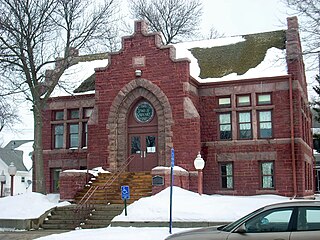
Joseph Schwartz, known also as Josef Schwartz, was a notable architect of Sioux Falls, South Dakota.

The Palmetto Building, built during 1912–1913, is an early skyscraper in Columbia, South Carolina. It was designed by architect Julius Harder, and Wilson and Sompayrac served as supervising architects. Upon completion it was the tallest building in South Carolina.

Wallace L. Dow (1844-1911), often known as W. L. Dow, was an architect of Sioux Falls, South Dakota. He has been referred to as the "Builder on the Prairie" and was "considered the premier architect of South Dakota in the late 19th century."
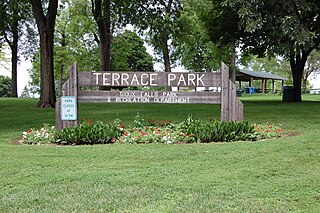
Terrace Park, historically known as Covell Lake Park or Phillips Park, is a 52-acre (21 ha) public park on the shores of Covell Lake in Sioux Falls, South Dakota. Founded in 1916, its modern name is derived from its steep terraces. It was listed on the National Register of Historic Places as Terrace Park and Japanese Gardens in 2015.
Weary and Alford Company was an American architectural firm with partners Edwin Delos Weary and Willam Headley Alford. The firm was known for its design of office buildings and bank buildings and was headquartered in Chicago. The firm also employed Oscar Wenderoth, E. F. Weary, and R. D. Weary. Several buildings designed by the firm are listed on the National Register of Historic Places (NRHP).

Historic Hotels of America is a program of the National Trust for Historic Preservation that was founded in 1989 with 32 charter members; the program accepts nominations and identifies hotels that have maintained their authenticity, sense of place, and architectural integrity. As of June 5, 2015, the program included over 260 members in 44 states, including the District of Columbia, Puerto Rico, and the U.S. Virgin Islands.
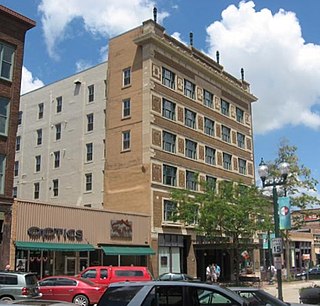
The Carpenter Building, historically the Carpenter Hotel or Hotel Carpenter and known colloquially as The Carpenter, is a historic building at 221 South Phillips Avenue in downtown Sioux Falls, South Dakota. Originally serving as a hotel from 1912 to 1966, it is now used for retail and apartment space. It was listed on the National Register of Historic Places in 1986.

The Security Bank Building, also known as the Security Building, is a historic commercial building at 101 South Main Avenue in downtown Sioux Falls, South Dakota. It was the first steel-framed office building to be built in the state. It was added to the National Register of Historic Places in 1984 for its architectural design and integrity, as well as for being the site of a bank robbery by the Dillinger Gang in 1934.

All Saints Historic District is a 70-acre (28 ha) area in Sioux Falls, South Dakota. Consisting mainly of over 374 late 19th- and early 20th-century homes, it is named for one of its landmark contributing properties, the All Saints School. It was listed on the National Register of Historic Places in 1984.



















